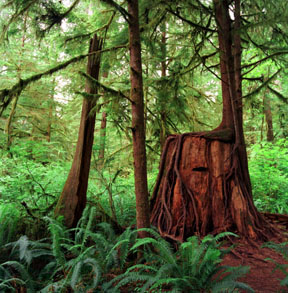Under the Canopy, Sol Duc Valley
Located in the north-central portion of the park, this is a view of the old growth forest between the Sol Duc Hot Springs resort and Sol Duc Falls. A tributary to the Sol Duc River meanders through douglas fir and western hemlock, ferns, moss, and lichens.
Print No. A99NW-9-11
For a limited time, available for
1/2 price.
Maidenhair Fern, Hoh Rainforest
Northern maidenhair fern (Adiantum pedatum) is a deciduous fern named for the fine, dark hairs of its roots. It is found along the wet, rocky stream banks in the Hoh Rainforest. Ferns were among the first land plants, with fossils dating between 350 and 400 million years ago.
Print No. A99NW-9-5
Hoh River
The Hoh River begins as meltwater from the glaciers on the north side of Mount Olympus. The meltwater carries abundant rock flour, fine sediment in suspension, from the scouring action of the glaciers as they pass over the bedrock around Mount Olympus. This rock flour gives the river a milky, or opaque sky-blue color.
Print No. A99NW-8-3
Pattered Western Hemlock, Queets Rainforest
Western hemlock is known for its broad fan-shaped branches. Set together, the branches merge into a seemingly repeating pattern.
Print No. A99NW-7-5
Regrowth, Quinault Rainforest
This view is from the nature walk near the U.S. Forest Service Quinault Station at the southwestern edge of the national park boundary. It is apparent that logging of old growth stands have occurred here in the past.
Print No. A99NW-6-1

Coat of Moss, Quinault Rainforest
This view is also from the nature walk near the U.S. Forest Service Quinault Station. Symbiosis is the rule in the rainforest as the moss is nurtured by the host tree and in turn acts as a protective coat.
Print No. A99NW-6-4
Hurricane Ridge Viewpoint
Looking southwest from mile-high Hurricane Ridge, you get a close glimpse of Mount Olympus, the highest point in the Olympic Peninsula. The west peak of Mount Olympus, usually shrouded in clouds, rises up 7,965 feet (2,428 meters) above sea level. The glaciers mantling Mount Olympus, headwaters of the Hoh River, lie in the u-shaped valleys carved by the flowing ice.
Print No. A99NW-11-1






